 |
 |
News  General General 
XRAY Column #65 - Making the T4, Part 2 |
|
 |
| |
|
|
| Several RC magazines around the world have asked us to write a monthly column. With the kind permission we will re-publish the column at our web site too so all of the XRAY fans can read the latest news and behind the scenes information. Enjoy. |
|
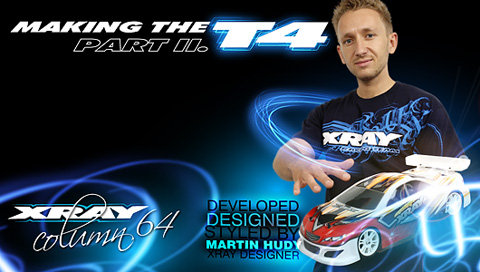
(click to enlarge) |
|
| Testing in Scandiano, Italy: |
|
| The first testing of the new car was planned for January 2012. The traction level at our internal test track was too low to simulate big-race conditions, so I decided to travel to Scandiano, Italy. Scandiano is home to a nice track that is heavily used, so has developed excellent traction. More importantly, the traction levels are consistent which allows the testing of multiple parts to determine which components make the biggest differences. In order to be objective in the testing, I decided to involve Alex in the testing session so that we could have more than one set of observations. Thankfully, our timing allowed us to arrive in Scandiano safely, narrowly missing a major snow-emergency that forced the closure of many roads and highways. |
|
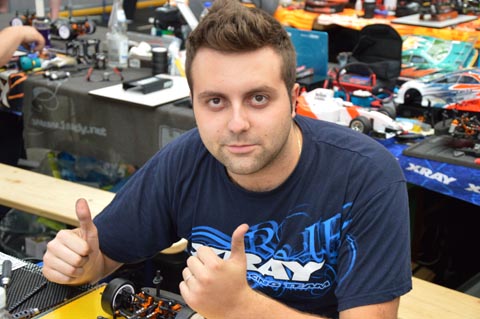
(click to enlarge) |
|
|
|
Testing was very difficult, as the track had no climate control system and the temperature in the hall was only 4 degrees. It was hard to drive in these conditions as my fingers felt as though they were freezing to my radio, but I was so excited about testing that I did not care. The testing session took 4 days. On the first day we tested the current T3 2012 to understand how the car handles on this track and establish a baseline for comparison versus the prototypes.
We had worked out what felt like a perfect set up for the T3 2012 on that first day of testing, so Alex and I were both eager to see how the new prototypes would perform. At this early stage I had prepared the short shocks and shock towers, but I was using standard springs. I had also brought along 4 different motor mounts to help in determining a direction for continuing development. It was very exciting moment when I put the car on the carpet and slowly start to drive first laps with the new car. What really surprised me was how quickly I got used to the new car, improving my fastest lap by 0.1sec vs. the T3 2012 within the first few packs. Immediately, I felt that this new car was super stable, had more traction and that it changed direction more quickly. This initial result exceeded my expectations. I let Alex take over the testing so I could observe from trackside. I grew even more excited about the results when Alex improved his best lap time by 0.2 seconds after only 10 laps! Alexâ™s feedback agreed with my earlier observations. Our excitement was tempered by the amount of work in front of us. We had to test all of the new prototype parts and compare them with standard parts in order to understand which parts make the car faster. |
|
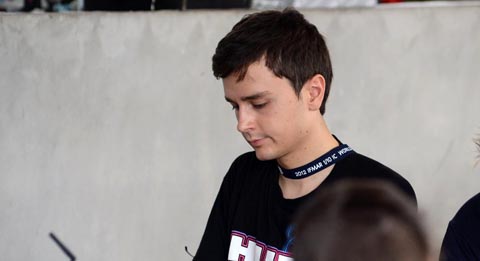
(click to enlarge) |
|
|
|
| We began by testing the new shocks. To confirm whether or not the new shocks were an improvement I would need to compare both the new and old versions directly on the same car. To accomplish this, I made shock towers for the standard shocks that would fit the new car. We proceeded to test the short and long shocks back-to-back. The observed difference in handling was significant. Even though the car felt like it had more steering with the long shocks, the lap times were consistently slower as the car stopped more in the corners and was more difficult to drive. The overall consistency of the lap times also improved with the short shocks, with a smaller discrepancy between the fastest and slowest lap times. This was a great signal that we were moving in the proper direction. To better understand how the new shocks work, we decided to also test combinations of long and short shocks. In subsequent rounds of testing we tried using long shocks in the rear and short shocks in the front, followed by reversing this situation and running short shocks in the rear and long shocks in the front. We came to the conclusion that the short shocks make the biggest impact when used on the front, as they make the car smoother and make it steer more easily. |
|
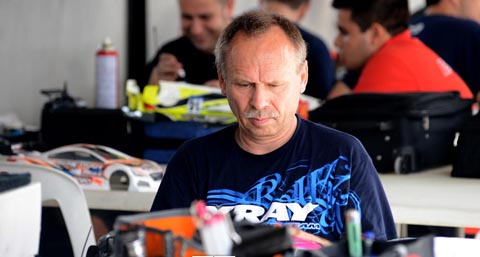
(click to enlarge) |
|
|
|
It made me super happy that the new shocks worked really well as this was the main feature of the new car, and was something what would differentiate our car from all of the others. I remember when Paul Lemieux told me during the Worlds Warm-up race some months later, after driving the car for the first time that he never wants to drive the old car again as all of the other cars now look like tractors to him!
Even though the new shocks were working very well right from the beginning, I realized that car with the new shocks felt as though it had stiffer damping. With the T3 2012 we used 400cSt shock oil, but when we put 400cSt shock oil into new shocks it felt much stiffer. This troubled me, as I was unable to understand why this could be. My intention was not to make any mistake or take any unnecessary risks with the new shocks. Even though I wanted to make them lower I did not want to gamble with the size of the shocks and therefore I chose to play it safe and use the same internal volume of oil. Careful calculations were performed to ensure that we would achieve this target.
While testing in Italy, I was concerned about the shock oil problem as, in my opinion, everything was correct and I could not find out why the new shocks worked harder. I did not have my computer workstation with me, so I was unable to check the drawings to determine if I had made a mistake. The only thing we could do was to soften the shock oil until we were able to get the new shocks damping at the same rate as the old. Luckily, some local 1/12 drivers arrived at the track with some very lightweight shock oils. We found that 200cSt shock oil in the short shocks worked the same as 400cSt shock oil in old shocks and that the car was with this new shock oil even 0.1 sec faster than before. This meant that Alex had improved his best time by 0.3 seconds compared to the T3 2012. Alex and I both left Scandiano more than happy with these first tests. |
|
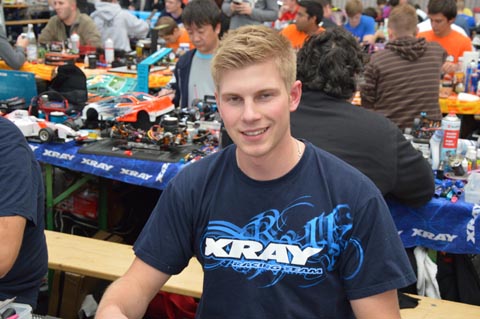
(click to enlarge) |
|
|
|
| When I arrived home I was still curious about what had happened with the new shocks. I verified all of the component detail drawings and compared them with the prototype pieces. I realized at this time that the production team had made a mistake in the machining of the prototype pieces and that the pistons were oversized by 0.1mm on the diameter and that the piston holes were undersized by 0.1mm compared to the drawings. This greatly restricted the flow of oil within the shocks, resulting for the stiffer feel. This can sometimes happen in the prototyping stage, as many parts are still hand-made at this point in the process. |
|
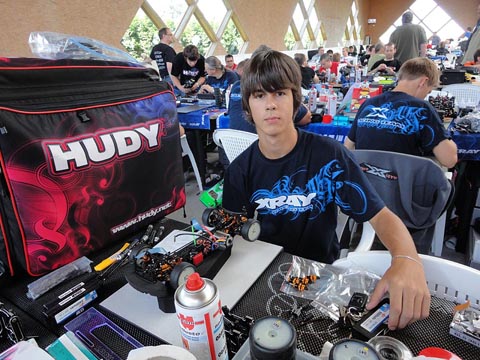
(click to enlarge) |
|
| Testing at ETS in Grand Canaria: |
|
Even though Alex and I continued to test the prototype parts on carpet, the second real test came in March when Alex went to Gran Canaria for the ETS race. I was occupied with some other very important priorities at home so was unable to attend the race, leaving Alex to do all of the testing alone. In order to get in as much testing as possible, Alex arrived on the Monday leading up the race. I kept in touch with Alex via text messages during his testing period to keep up to date with his progress. After 3-4 days of testing Alex was 0.2 seconds faster with the new car than his T3 2012, and his feedback would prove valuable for the continuing development. Unfortunately, it was not time yet to reveal the new car in an official race, which was disappointing to Alex as he was so excited about the carâ™s performance. At the end of the race, Alex finished 2nd with his old car. When you consider that Alex had previously indicated that he was 0.2 seconds faster with the new car, could the outcome of the race have been different had he been allowed to use the new car? We can only speculate.
Testing at XRAY Challenge in Trencin:
The next test was held in Trencin, at my home asphalt track and it was planned after the XRAY Challenge in May. This time Francesco Martini came from Italy to join us to help us with testing. Since Francesco is a regular driver his input and feedback was very important because it would help demonstrate to us which changes would best benefit our customers. It is always important to have two different views and perspectives, one from top drivers but also from a regular driver. Top drivers can often overcome the shortcomings of a car that is not set up perfectly however, for regular drivers, this can often prove difficult, if not impossible, to overcome. Francesco is a very experienced and technical driver and his input has been always very constructive so I was happy that Francesco came to help us and I was confident he would be a great asset. It was actually an idea from Francesco that led to the XRAY development and introduction of the independent, center-mounted servo. This concept has now been imitated by companies and manufacturers around the world. |
|
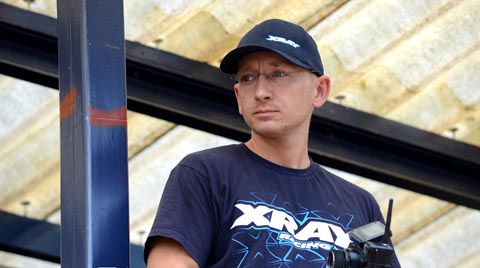
(click to enlarge) |
|
|
|
| The test session in May at the factory test track was the first time we tested the short springs compared to the long ones. During this session we also tested different chassis thicknesses (2mm, 2.2mm and 2.5mm) to determine which would be the ideal choice. I had already used the new car at the XRAY Challenge race and both Alex and Francesco were jealous as I was 0.3 sec per lap faster than everyone else and they were both aware of the performance gains that the new car had given me. When we continued private testing on the Monday following the race Alex was able to use the new car and was right away running the same lap times as me, making my unfair advantage disappear. While testing the springs we realized that, with the short springs, the car was even more stable and easy to drive. During testing and back-to-back comparisons between linear and progressive springs we concluded that the progressive springs worked very well on both carpet and asphalt and were our preferred choice. The different chassis thickness test was challenging, with plenty of data recorded and many details to be evaluated. From all the different thicknesses tested we all found and agreed that the 2.2mm is best compromise both for carpet and asphalt. The testing session at our factory tracks was very effective and successful and again helped us to continue to move forward with the new car. |
|
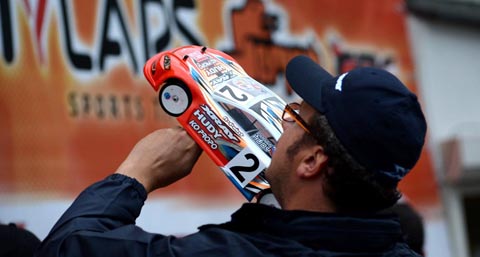
(click to enlarge) |
|
| Testing at Worldâ™s warm-up in Heemstede, Netherlands: |
|
As I had objective feedback and I knew that we are moving in the right direction, we came to the point in development when we believed it was the right time to make more prototypes and get them to the team to collect more feedback from more varied tracks conditions. The first big team test was planned for the Worlds Warm Up in Heemstede, Netherlands in June. We made the cars for team drivers who went to this race and who planned to attend the Worlds as well. Running the T4 prototype would be me, Juraj, Alex, Francesco, Paul Lemieux, Alessio Maniccuci, Magnus Vassmar, and David Ehrbar. All of these drivers received the prototype plus 3 different motor mounts with different design ideas which we needed to test and evaluate.
As soon as we arrived in Heemstede, we all started the testing using a common procedure. First we tested the T3 2012 car and tried to find the best possible set up. We had one week for testing alongside other teams, which was really good as we could also compare our car with the other brands. After the first day, we found a very good set up on T3 2012 and we were on the same pace as all of the other teams. |
|
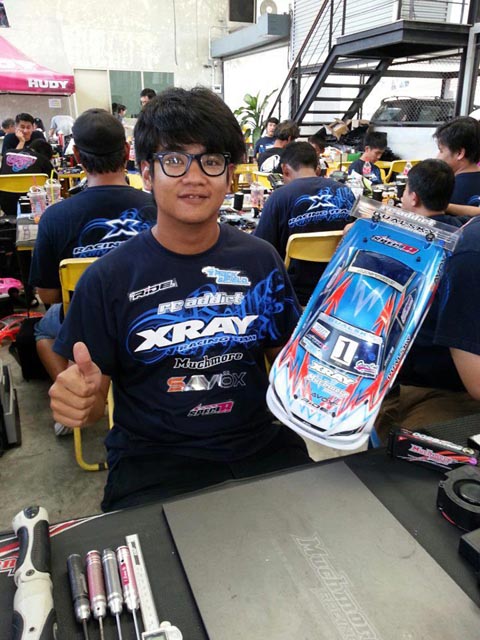
(click to enlarge) |
|
|
|
The next day was the exciting one, as everyone one of our selected drivers would be running the prototype car. Once again, I had a deep feeling of satisfaction as I watched our drivers getting faster step-by-step, before even beginning to work on the carâ™s setup. Paul Lemieux was the one who improved his lap times most significantly. Paul was super fast right from his initial runs, but suddenly he was the fastest of all drivers at the track. Our competitorâ™s took notice and suddenly other drivers began to wander near our pits to scan our new developments. We had to be careful that we did not reveal to our competitors what we had been working so hard to develop. We had worked hard for over half a year on the new car and it was only 1 month until the World Championships, so we wanted to keep our new weapon secret. 1 month could still provide adequate time for our competitors to attempt to mimic what we had developed if they were able to spot adequate details. It was amusing to note that even though we moved our pit area far away from the main crowd we were still frequented by many visitors. Drivers and teams who had paid us little attention before were now drawn to our pits and became very talkative. We tried to be as careful as possible and always kept the cars covered by their bodies, yet it was obvious to us that, when these talkative competitors came to visit, their eyes were scanning the open window areas of our cars searching for the secrets contained under the body shells :o)
The whole week was very successful for us and I was more than happy as I was receiving only positive feedbacks. We tested 3 different motor mounts, and again I was super happy when all drivers agreed that the separate motor mount worked best, which closed another open question in the development. In summary, we enjoyed the Worldâ™s warm-up with Paul taking the TQ and the overall win. I was travelling home more than happy and very satisfied that we are moving in the right direction and that the whole development portion of the project was nearing completion. |
|
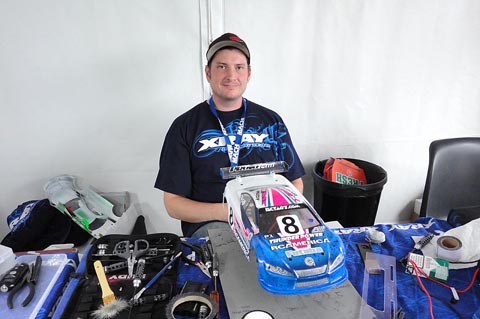
(click to enlarge) |
|
|
|
Back at the office we had a meeting to discuss the start of mass production. In my opinion we were ready, but Juraj still had some ideas about chassis and top deck design and he had a feeling that we could still improve the performance and handling. As such we decided to wait with the production and to make some more prototypes to double confirm either the current design was final or if still there is some room for further improvements.
It was now the end of July, less than 2 months before the deadline when we needed to release the kits to be on time for the coming indoor season, and we were still not fully decided on the chassis and top deck and I had real nightmares and feared that we would not make it on time. After some more development and prototyping we had narrowed it down to the final two different chassis layouts with two different widths, both using the same graphite thickness. I tested them on asphalt and found my favorite one.
Testing in Scandiano, Italy:
As the new car should be released just in time for carpet season I needed to be sure that my favorite final chassis would work not only asphalt but also on carpet. The problem was that during the summer there are no races on carpet which meant that traction everywhere would be super low. I remembered Scandiano which is permanent track which is also used during the summer. Despite the lack of any major summertime races at Scandiano, the track is permanently in use and has consistently high traction. |
|
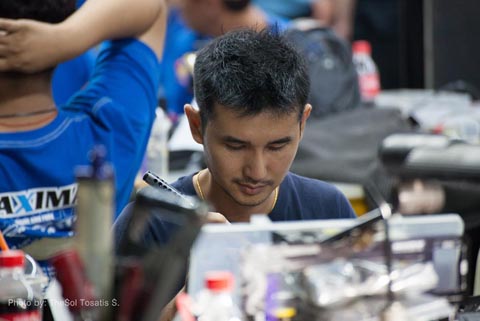
(click to enlarge) |
|
|
|
Unfortunately, I had the entire summer full of European championships races and would not be able to travel to Italy. I decided, instead, to package the prototypes and send them to Francesco for final assessment. Francesco packed a bag and left right away for Scandiano and vowed that he would remain on-site until he was able to report to me with a final decision on the chassis choice. After more than 4 days of non-stop testing and side-by-side comparisons he was able to confidently make his selection.
During the 4 days of testing it became clear that the world has become a smaller place. The amount of information being passed between Francesco and me in the form of data, emails, text messages, photos, lap times and more would not have been possible even a few years ago. We were able to accomplish remotely what would normally have taken a physical presence on-site. At the end of this communication Francescoâ™s selection for carpet, backed up by his performance data, was the same configuration that I had previously selected as my preferred choice for asphalt. I could finally deliver the good news to Juraj â“ the T4 development was finished and we could go forward with production. |
|
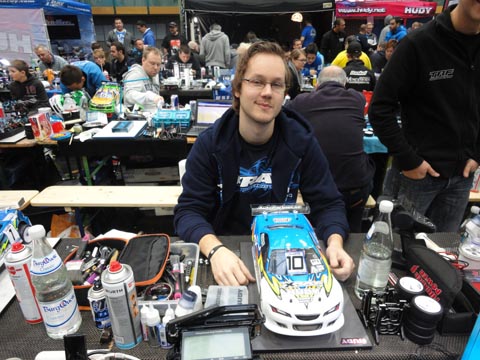
(click to enlarge) |
|
|
|
In just 6 weeks the T4 kits were produced, packaged and shipped on time for the first round of the ETS. I am sure that this is a new Worldâ™s record in speed of production. This âśperformanceâť was only possible due to dedicated efforts of our in-house manufacturing team, who used our capabilities and their professionalism to pull together as a team, working 24 hours a day and 7 days a week to meet this critical deadline and of course all the in-house manufacturing without the need to wait for external suppliers.
Now you have your T4 in your hands and can judge and evaluate the work we did. My hopes are that the best judge will be your improved lap times.
Enjoy and I am looking forward to hearing from you. Share your feedback and experiences at our forum at http://forum.teamxray.com
Yours
Martin Hudy
PS: Remember to follow me on Twitter at www.twitter.com/MartinHudy
PPS: I would like to thanks everyone who has participated during the year on the T4 development in any of the many phases. The thanks goes particularly to Alex Hagberg, Francesco Martini, Paul Lemieux, Zdenko Kunak, Magnus Vassmar, Alessio Menicucci, David Ehrbar, Marco Kaufmann, Surikarn Chaidajsuryia, Meen Vejrak. Big thanks to Juraj for providing the non-stop guiding and input throughout the project and thanks to everyone in-house for the Worldâ™s fastest production to get the car on time. |
|
|
| Thanks to RedRc and RC50.com for photos. |
| Archive: |
|
Column #1 - Behind the Scene Stories
Column #2 - Worlds Flashback
Column #3 - T2'007 Debut
Column #4 - Designing the T2'007
Column #5 - Worldcup Review and NT1 Testing
Column #6 - Developing and Designing the NT1
Column #7 - Developing and Designing the NT1 - Part 2
Column #8 - Back to the Races
Column #9 - XT8 Truggy Development
Column #10 - Touring Car Development
Column #11 - Bling-bling Mentality
Column #12 - Hot Summer Washout
Column #13 - New Electric Touring Car
Column #14 - Off-road Development
Column #15 - My micro love
Column #16 - Back in the Dirt
Column #17 - Worlds Preparations
Column #18 - 808 Tests & Stress
Column #19 - Excited for the Worlds?
Column #20 - Statistics, Expenses Sheets, Production Analysis, Calculationsâ¦
Column #21 + Column #22 - Euros + Euros + Worlds
Column #23 - The Busiest Season Ever
Column #24 - In Between the Worlds
Column #25 + Column #26 - Well Developed or Overdeveloped?
Column #27 - Back to The Future
Column #28 - 2009 Kick-off
Column #29 - Crazy what?
Column #30 - Last indoor race of the season
Column #31 - Getting into summer season
Column #32 - Heading for the Euros
Column #33 - Testing - Always last minute, always new ideas
Column #34 - European Champion - title celebration
Column #35 - Time to move on
Column #36 - National Heroes
Column #37 - 2010 ready
Column #38 - Decade of Triumph
Column #39 - 2010 Racing Calendar
Column #40 - DHI, ETS & NĂĽrnberg Show
Column #41 - World Championship Practice
Column #42 - EC indoor, EC 1/12, Silverstate, LRP Masters, Neo
Column #43 - Nationals All Around
Column #44 - Warm Warm-ups, Challenging Challenges
Column #45 - Electric Touring Worlds 2010
Column #46 - Team XRAY - World Champion!!!
Column #47 - Summer Vacation, 30x USA Champion Title
Column #48 - T3 Saga Continues
Column #49 - RX8 â“ What? How? When?
Column #50 - The Making of the RX8 â“ Part II
Column #51 - Shake It, Baby, Shake It...
Column #52 - Racing Season â�11 Full Running
Column #53 - From On-road to Off-road
Column #54 - Testing and Once Again⦠Testing
Column #55 - Half of the EC Championships â“ Done!
Column #56 - Summer is Goneâ¦Euros are Done
Column #57 - Never-ending Development
Column #58 - From XB8 to XB9
Column #60 - 2012 Season Running
Column #61 - Crazy Months
Column #62 - ETS Champion
Column #63 - 2012 Racing Summer Summary
Column #64 - Making the T4, Part 1 |
|
|
|
|























